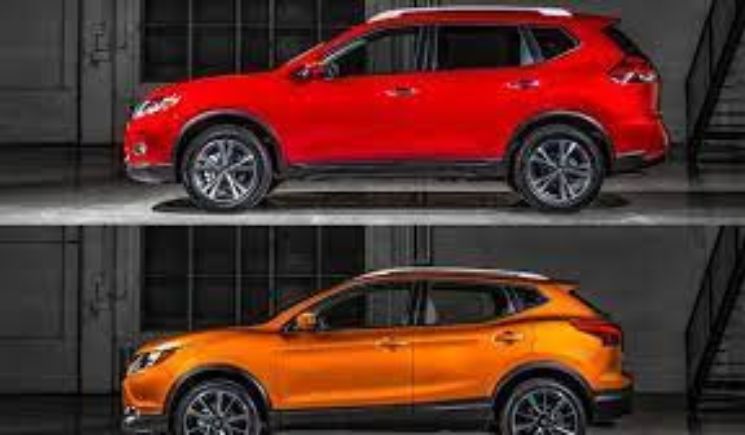The Nissan Rogue and Rogue Sport looks similar, but they are quite different vehicles underneath.
The Rogue is a compact crossover SUV, while the Rogue Sport is a little bit closer to a subcompact SUV.
Understanding the major differences can help you to determine which model best fits your needs.
Size and Styling
- The standard Rogue rides on a longer wheelbase is 14.5 inches longer than the Rogue Sport.
- That makes the Rogue more spacious for passengers and cargo.
- The Rogue has up to 70 cubic feet of storage space compared to just over 50 cubic feet in the Rogue Sport.
- Styling cues are shared between the two crossovers, including the large V-Motion grille and boomerang headlights and taillights.
- However, the Rogue has a more aggressive, athletic stance compared to its “Sport” sibling.
- The Rogue also comes standard with 17-inch wheels and 16-inch wheels on the Rogue Sport.
Powertrains
- The powertrain choices differentiate the two vehicles significantly.
- The standard Rogue engine is a 2.5-liter 4-cylinder which makes 170 horsepower.
- The upgraded option is a turbocharged 1.5-liter gas engine in the Rogue Sport which makes just 140 horsepower.
- This gives the regular Rogue much quicker acceleration.
- While they share no engines in common, both models are available with front-wheel drive or optional all-wheel drive systems to handle the slippery conditions.
- But the fuel economy does some favor for the Rogue Sport slightly at 7-10 mpg, that is much more better per tank.
Interior Comfort
- You’ll enjoy more passenger room and comfortability in the Rogue’s cabin.
- The Rogue boasts superior headroom and legroom dimensions both in the front and rear seats compared to the Rogue Sport.
- And getting in and out is easier with the Rogue’s lower step-in height.
- Cargo space and overall utility are also better suited to families with the Rogue model.
- The Rogue can fit large strollers, playpens, golf clubs and other sizeable gear that may not squeeze into the tighter Rogue Sport cargo hold.
Pricing
- MSRP pricing overlaps the Rogue Sport and Rogue despite their relative size differences.
- The Rogue Sport starts around $23,000, ranging up to roughly $30,000 for an all-wheel drive model that is fully equipped.
- Meanwhile, the entry-level FWD Rogue retails for about $26,000, with top trims going up to $37,000.
- The similar pricing demonstrates the premium features packed into the more compact Rogue Sport.
- But when it comes down to pure interior space, versatility and performance, the standard Nissan Rogue easily wins out.
Technology & Safety
- The Rogue offers some extra high-tech features and driver assistance over the Rogue Sport.
- Optional upgrades on higher Rogue trims include a digital dashboard, heated rear seats, wireless phone charging, Bose premium audio, and a motion-activated liftgate.
- Safety tech like automatic emergency braking, lane departure warning, blind spot monitoring and rear cross traffic alerts are included across more Rogue trim levels which is limited to only the top Rogue Sport models.
Off-Road Performance
- Neither vehicle excels at serious trail-driving, but their availability of all-wheel drive systms do enhance the traction and control in slippery conditions.
- The Rogue Sport AWD may have a slight edge for those tackling rutted dirt lanes or deeper snow though.
- The Rogue Sport sits almost an inch higher off the ground by providing more ground clearance.
- Approach and departure angles are also improved in the Rogue Sport due to its shorter front and rear overhangs.
Ride & Handling
- The Rogue delivers a more compliant highway ride than its sportier sibling.
- The long wheelbase smoothes out cracks and bumps in the pavement.
- Handling leans more to understeer and comfort than quick reflexes when pushed.
Frequently Asked Questions About Nissan Rogue and Nissan Rogue Sport
Q: Which one has the more excellent interior layout?
A: The Rogue Sport borrows interior styling from the much pricier Nissan Murano crossover. You’ll get a richer-looking leatherette and soft-touch materials for a more upscale feel inside the compact Rogue Sport. On the other hand, the Rogue interior appears more basic by comparison.
Q: How do ownership costs the compare?
A: The Rogue Sport rates slightly better fuel economy — 28 mpg combined for FWD models and 26 mpg with the Rogue. And starting MSRP on the Rogue Sport allows for lower initial purchase costs. But the Rogue earns higher dependability scores by suggesting potentially lower long-term maintenance & repair expenses.

